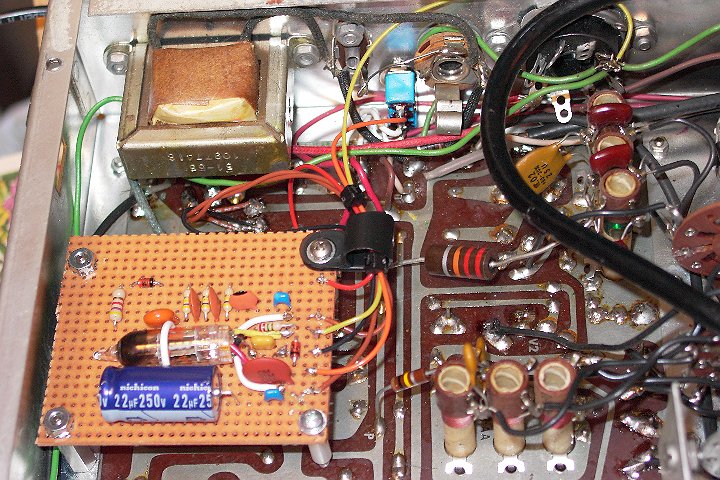N5ESE Sidetone Oscillator for Tube Circuits (2010)
(used in my Heathkit HW-16)

(click on any picture to see larger version)

(click on any picture to see larger version)
The Heathkit HW-16 is a tube-based CW receiver-transmitter intended for the Novice licensee back in the 1960's & 70's.
It had a crystal-controlled transmitter and an amazing receiver - and full QSK (break-in keying) that was absolutely flawless.
And, dang it!, it had a neon-bulb relaxation-type sidetone oscillator that would grate the rind off the most spacious old-time
spark operator.
I love my HW-16, but something had to be done. A solid-state solution would disrespect the fine vintage tradition of this
classic rig, so I wanted to come up with something worthy. But I really didn't want to drill a large hole for a new tube socket (and
anyway, you pretty much can't, because of the PCB), so the best option to fit the conditions was to use subminiature "pencil" tubes.
Using a pencil tube, I could build on PCB-type perf board, and fit it under the chassis - and still be "hollow-state".
Here's what I came up with:

Note that all the references to input/output and connections refer to this particular installation, and are unique to the HW-16. But the design could easily be
adapted to most any grid-block keyed transmitter. Most any audio-type medium-mu or hi-mu triode should work, like one-half of a 12AX7 (9-pin tube) or
12AT6 (7-pin) or 6AB4 (7-pin) - that is, if you don't mind punching a hole for a socket.
This design uses a single hi-mu triode (5719) in a classic phase-shift oscillator. With 4-stages of R-C phase shift, the design gives "near" sinusoidal
output. Below, you can see the output waveform. But you will really appreciate the effect by listening to this "before-after" audio file.
You'll notice that I added a switch (rear panel) to allow me to select between the new sound and the old buzz (just in case I miss it).
The 47V zener in series with the plate supply was necessary to keep within the ratings for plate voltage on the 5719 pencil tube. If you instead use
a more conventional tube choice (like the ones mentioned above), you won't need that zener.
Below is a picture of the under-chassis installation of the sidetone perf board in the HW-16.
Click on it to see annotations and reference designators.
